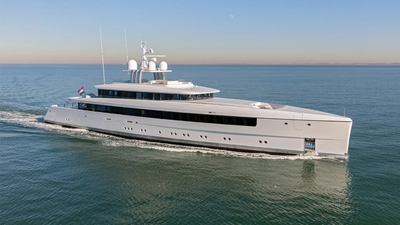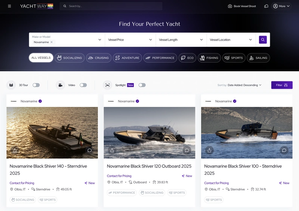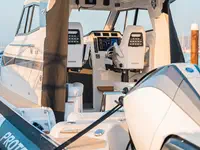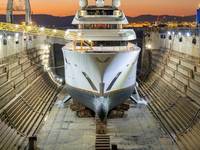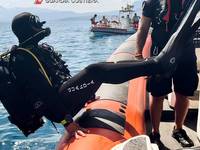Najiba: Designed for Sustainability
Since her launch earlier this year the 58-meter Feadship Najiba has displayed exceptional efficiency.
Figures following sea trial for Najiba were keenly anticipated by a large group of stakeholders, from the Feadship Aalsmeer yard responsible for her engineering and construction, the naval architects & engineers at Feadship De Voogt, the designers & naval architects at Vitruvius Yachts, and the inspiration behind the overall concept, Philippe Briand.
Najiba was unusual in the sense that her owners had already decided to work with a particular design by Vitruvius Yachts and a specific hull initially conceived by Philippe Briand before they came to Feadship. The slender lines and distinctive vertical bow are based on Briand’s experience with designing fast sailing yachts. Najiba is also the also second largest Feadship to be built in aluminium to date, saving weight and adding to the potential savings on fuel consumption.
Many months of planned naval architecture and several years of construction later, Najiba was launched in January 2019. Her sea trials in February indeed confirmed that the approach chosen by the owners had paid dividends. Najiba’s average fuel consumption is as low as 11.4 liters per nautical mile at her cruising speed of 12 knots, between 20% and 25% less than any equivalent motoryacht of this size. The yacht also has a top speed of 17 knots, outstripping the original goal of 16 knots, while her range came in at over 6000 nm, more than a thousand over the specified figure.
“These results mean that – despite the complexity of her development and build – we have outperformed all expectations with Najiba,” comments Roderick de Vries, technical director of the Feadship yard in Aalsmeer. “It was a real ‘wow’ moment for everyone involved to see this level of efficiency achieved during the sea trials. It is one thing to design such an efficient full-displacement motoryacht but another to translate these lines and shapes into a stunning Feadship that is even faster and more fuel-efficient than we projected.
“Working very closely with Vitruvius, hull efficiency was the leitmotif of the project from an engineering perspective. It impacted every decision made about appendages like the bowthruster, propeller shaft, stabilizers and main exhaust. We had to strike exactly the right balance between Philippe’s desire to minimize all sources of resistance and the Feadship values of ensuring total comfort for clients, ease of maintenance for crew and the smartest construction. It was a fascinating challenge at times but we have managed to combine the best of both worlds and Najiba is a true Feadship.”
“We leveraged on our decades of experience with sailing yacht designs to optimize the hull lines, proportions and weight of the boat,” Briand said. “There are various parameters involved in the resistance of the hull. For example, for a given overall length, the optimum is to have a plumb line bow with a maximum wet waterline. Another parameter is to try and reduce the wetted area – the area of the hull immersed in water – as this has the greatest impact on cruising speed. We also optimized the pressure on the hull and reduced wave drag by ensuring the smoothest possible distribution of the lines.
“At Vitruvius we are used to designing boats in aluminium, which obviously leads to savings in weight and reduces displacement. As the inertia of the boat is less, so too is the wave resistance when underway and the degree of pitching. These, in turn, lead to further reductions in fuel consumption. Aluminium also brings extra benefits in terms of motion comfort, as was instantly perceptible during Najiba’s sea trials.
“Together with Feadship we believe that this project has been a crucial step on the road to greater superyacht sustainability, a path that we expect more owners to follow in the years ahead. Najiba is a genuinely innovative motoryacht and she illustrates what can be achieved when two expert parties share their knowledge and experience to attain a greater goal.”
Annemarie Steenbergen, who led the team of naval architects at Feadship De Voogt, enjoyed working with Briand and Vitruvius.
“Najiba has a different hull shape from any previous Feadships, showing curvature in all degrees. The hull shape isn’t straight from the waterline up to the main deck. A cross-section halfway through Najiba’s hull shows she is like a half moon, with a smaller beam on the waterline than at deck level. The bow area is also different. Feadships usually have a horizontal keel with the radius in front, especially with straight bows, before rising vertically. Najiba has a raised keel from approx. one third to the bow, resulting in a reduction in resistance without any compromise on maneuverability.”
Feadship already has its own efficient engineering and naval architecture procedures, and the Najiba project proved that these can also be adapted to different designs from different sources. “We received the lines plan in the Vitruvius program and transformed it into our own,” adds Steenbergen. “The hull design was very much Philippe’s but we ensured it could be built according to Feadship procedures and standards. Height stacking was another challenge as the sleek design sought to push the vertical center of gravity down and save weight. We successfully accommodated the smaller distances between each ceiling and the deck above.”
